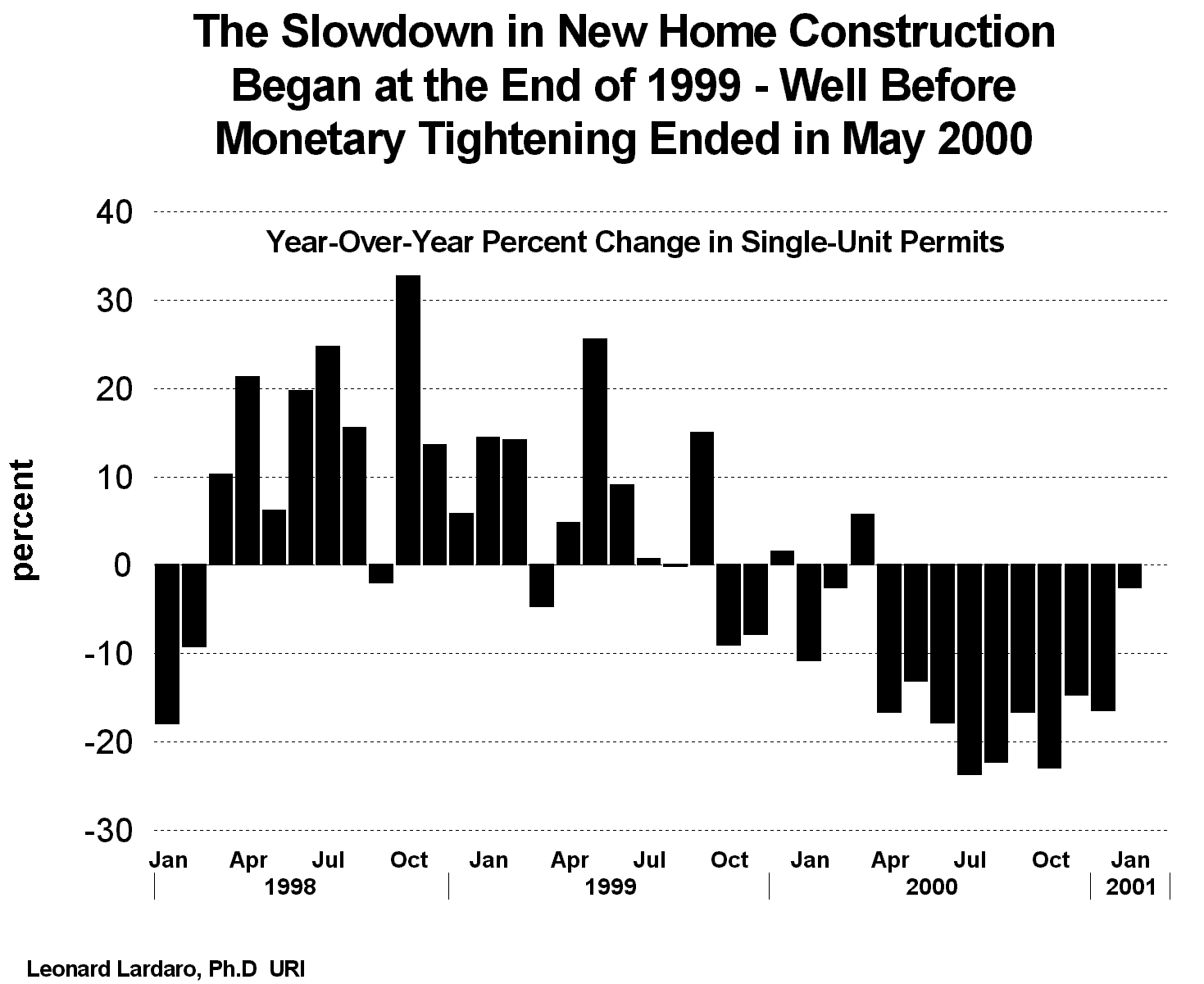|
|
DECLINING
BUILDING PERMITS DEFY STATE'S DEMOGRAPHICS
The
Providence Business News, March, 2001
For several years now, far too many persons have gauged
Rhode Island's housing market performance solely in terms of existing
home sales. Based on that single indicator, the housing market has
performed exceedingly well, setting several records over the past
decade. While existing home sales have slowed of late, failing to set
yet another record in 2000, the number of homes sold remains high by
historical standards, comparable to the levels we witnessed in 1998.
And, even though annual home sales declined last year, this was a
manifestation of economic strength: given the high volume of sales over
the past decade, the supply of existing homes fell dramatically. Were
the supply higher, there is every reason to expect that we would
actually have matched or beaten the most recent sales record last year.
As this illustrates, declines in economic indicators are not always a
reflection of weakness. So, even as the Federal Reserve continues to
lower interest rates in the coming months, existing home sales, which
will continue to be constrained by a lack of supply, will not respond as
positively as they would have absent this "supply constraint."
Permit me to complicate things further. As the pace of national,
regional, and state economic activity continues to slow during the first
half of this year, supply constraints will be a less dominant factor in
determining existing home sales than they were in 2000.
Confusing? Yes it is. It illustrates the way that economics analyzes the
interaction of the host of factors that determine how an indicator of
interest is likely to change. Will the influence of the positive
(declining rates) outweigh that of the negative forces (supply
constraints and slower economic activity)? I don' think so. I expect
existing home sales to fall again in 2001.
But a proper assessment of the performance of Rhode Island's housing
market must include new home construction, as measured by single-unit
housing permits. I was very happy to see the lead story in last week's
Providence Business News, "R.I. home building begins to lag."
I have been studying Rhode Island's housing market for years. My Current
Conditions Index includes both these housing market indicators.
The home building article discusses the recent behavior of single-unit
permits. Like existing home sales, monetary policy and the pace of
national economic activity also affect the number of building permits.
So too does the lack of existing homes to sell. Let me confess, though,
that I have found the behavior of building permits throughout this
entire recovery to be very difficult to understand.
For years, Rhode Island was unable to break through the 2,500
annual-unit level of permits. Finally, we surpassed this for both 1998
and 1999. Then, in April of last year, just before the cycle of monetary
tightening was completed, housing permits began to decline at
double-digit annual rates. At first I thought this was a temporary
"blip." It quickly became apparent that something else was at
work.

Single-Unit Housing Permits and
Growth Rates
(Seasonally Adjusted at Annual Rates)
|
|
Single-Unit
Permits
|
Year-Over-Year
Growth
|
|
Jan-99 |
2,709.5
|
14.4%
|
|
Feb-99
|
2,655.3
|
14.1%
|
|
Mar-99
|
2,327.3
|
-4.7%
|
|
Apr-99
|
2,715.5
|
4.8%
|
|
May-99
|
2,693.0
|
25.5%
|
|
Jun-99
|
2,749.8
|
9.0%
|
|
Jul-99
|
2,728.1
|
0.7%
|
|
Aug-99
|
2,690.5
|
-0.1%
|
|
Sep-99
|
2,621.5
|
15.0%
|
|
Oct-99
|
2,696.2
|
-9.1%
|
|
Nov-99
|
2,539.0
|
-7.9%
|
|
Dec-99
|
2,646.3
|
1.5%
|
|
Jan-00
|
2,415.3
|
-10.9%
|
|
Feb-00
|
2,587.3
|
-2.6%
|
|
Mar-00
|
2,459.6
|
5.7%
|
|
Apr-00
|
2,262.9
|
-16.7%
|
|
May-00
|
2,339.0
|
-13.1%
|
|
Jun-00
|
2,257.6
|
-17.9%
|
|
Jul-00
|
2,080.0
|
-23.8%
|
|
Aug-00
|
2,089.8
|
-22.3%
|
|
Sep-00
|
2,184.5
|
-16.7%
|
|
Oct-00
|
2,077.4
|
-23.0%
|
|
Nov-00
|
2,165.6
|
-14.7%
|
|
Dec-00
|
2,209.6
|
-16.5%
|
|
Jan-01
|
2,354.4
|
-2.5%
|
For years, all of us who analyze and forecast Rhode
Island's economy have pointed out that this state simply does not have
the demographics to support continued strength in new home construction.
In addition to this, several communities have permit caps, some land is
being set aside so development can't occur there, and, let's not forget,
we are a small state in terms of total land mass.
While some of the recent declines can be explained in terms of permit
growth caps and prohibitions on development, I find myself unable to
account for double-digit magnitudes of these decreases. Ironically, the
reason for this is Rhode Island's demographics. The new census revealed
that Rhode Island's population is substantially higher than anyone
thought: contrast the population estimate of 990,819 for July of 1999
with the April 2000 census value of 1,048,319. In about a year, when new
estimates are released by the Census Bureau, expect the original 1990s
data showing that we lost population for about seven years, to be
revised to show at most three (my guess) annual population decreases and
much more rapid population increases over the past few years. So,
contrary to what we knew before the census results were released, Rhode
Island has demographics that are much more favorable to housing
construction than we had imagined.
So, I can account for the recent declines in building permits but not
the magnitude of this decline. A more appropriate title for the article
in last week 's PBN would have been: "RI Building Permits Continue
to Lag In Spite of Its Demographics."
by Leonard Lardaro
|

